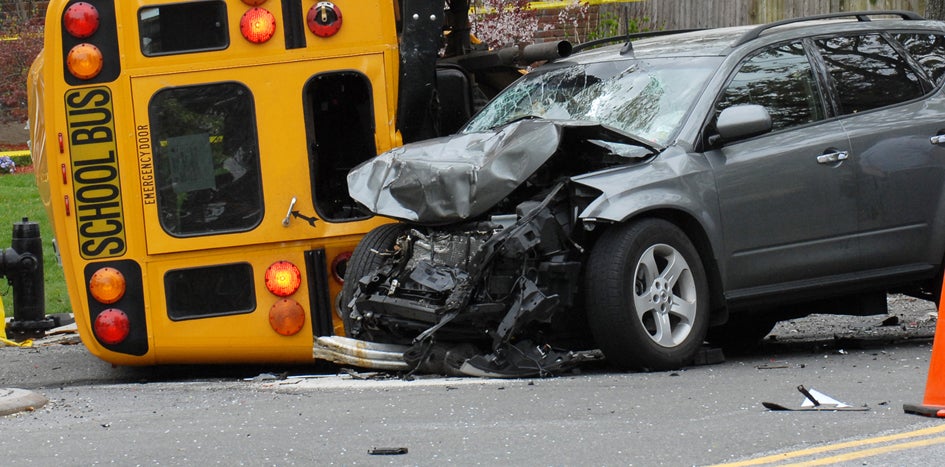How To Manage and Mitigate Your Burn Risks
Each year, about 400,000 people in the U.S. receive medical treatment for burn injuries. About 10 percent of those injuries occur in the workplace. Schools are not exempt from this risk: From bustling kitchens to science labs to maintenance and transportation shops, there are plenty of opportunities for burns to occur at your school or community college.
There’s no better time to prepare for these threats than Burn Awareness week, observed in the first week of February to highlight prevention of burn-related injuries.
Share these tips with employees
There are three main types of burns — thermal, chemical, and electrical. It is important to educate yourself about the hazards and share these safety tips with your team.
Thermal burns
Between a hectic work environment and constant exposure to hot fluids, food service areas present a wealth of opportunities for heat-related injuries. Make sure you are trained to prevent burn injuries by following proper work practices.
- Use protective barriers: Many kitchen burns can be prevented by putting a barrier between a person’s skin and a hot surface. Use dry, thick, well-insulated potholders or oven mitts that are in good condition when checking food on hot surfaces, placing food in boiling oil or water, or removing food from broilers, ovens, or microwaves. Keep potholders visible and within easy reach to ensure they’ll be used. You might need to use several layers of protective barrier to ensure your hands are protected.
- Communicate with co-workers: Use simple communication methods to notify co-workers when pots are hot. Simply placing a potholder on top can alert others to danger. You and your co-workers could also use simple verbal warnings such as “hot pan.” Whichever communication methods you choose, use them consistently and correctly.
- Be careful of splashes: Hot liquids and oils can cause burns. Use appropriately sized cookware for the volume of food and make sure not to overfill pots and pans. Always ask for help whenever moving heavy containers of hot liquids, and avoid splashing whenever placing food in pots and pans. Handling hot food inside cookware should be done with proper utensils such as tongs, turners, and spatulas.
- Protect yourself against steam. It is a leading cause of burns among food service employees. Direct steam away from you when removing the lid of a pot or pan by slowly raising the far edge of the lid with a mitt or potholders. Steam-related burns often involve food warmers. When opening warmers, stand behind the door, crack it, and let the steam escape. Follow the same procedure with double-stacked warmers, opening the bottom door first.
Employers can take another further step toward preventing burn injuries by installing safety devices such as built-in guard bars for grills and other hot surfaces automatic food-lowering devices and grease disposals for deep fryers, and exhaust systems. Some facilities might have built-in protection. For example, water heaters and mixing valves are already regulated to reduce scalding by hot water in sinks.
Chemical burns
Science labs might be the most obvious hotspot for chemical burns. However, this risk extends beyond the laboratory. Anyone who handles chemicals in your organization, including food service and cleaning staff, can face a serious burn hazard. Whether it’s part of their regular duties or they’re just handling disinfectants for a quick cleanup, any employee working with chemicals should know how to protect themselves and avoid getting burned:
- Rely on safety data sheets: You should be able to quickly find current safety data sheets (SDS) for every chemical you use. The sheets explain safety procedures for working with chemicals, including which personal protective equipment you should wear. If you cannot find an SDS or you cannot understand the information, tell your supervisor immediately.
- Store chemicals safely: Each chemical’s SDS includes safe storage instructions. Generally, you should keep chemicals in their original containers, with tight lids and in a secure area away from food and heat sources. Even something as seemingly harmless as hand sanitizer can present a fire risk when stored improperly.
- Learn how to treat exposures: Staff and students should always wash their hands after using or touching any chemical or equipment used with a chemical. Make sure everyone knows where to find the nearest eye wash station and understands how to use it if they get chemicals in their eyes.
Electrical burns
From nondescript electrical outlets to the most severe lightning storms, any source of electricity poses a burn risk. While maintenance staff performing work on your electrical systems are at the greatest risk of electrical burns, anyone who uses electrical devices faces similar hazards.
First and foremost, understand that an electrical burn might not be immediately visible. Electrical burns are caused by an electrical current travelling through your body and finding resistance in the tissue, creating a potentially deadly burn that might not even leave apparent marks on the surface of your skin. If you have made contact with electricity and suspect you have been burned, seek medical care immediately.
Practice these responsible behaviors:
- Don’t mix water and electricity: Make sure workspaces are completely dry whenever working with electricity. Even small amounts of water in electrical appliances can cause sparks, which can not only burn anyone they contact but also develop into large fires.
- Use protective equipment: Rubber gloves, sleeves, blankets, hoods, and helmets are examples of personal protective equipment you might use when exposed to electricity. Don’t forget to inspect every tool before use. Even small defects can put you at risk of electrical burns.
- Keep electrical outlets hazard-free: Anywhere you have an electrical outlet, you face a burn risk. Using common sense can go a long way toward protecting yourself: Keep electrical outlets free of foreign objects, keep all plugs and outlets away from water, and never use an appliance with a worn, frayed, or damaged electrical cord. The exposed wiring creates a potential hazard, so you should replace the cord or reseal it.
Treating burns
Unfortunately, burn injuries happen. First aid can prevent a minor injury from getting worse. There are four degrees of burn severity:
- First-degree burns only affect the top layer of the skin. They can be characterized by dry, red, and painful skin.
- Second-degree burns go deeper. These burns can blister and become noticeably red and sore.
- Third-degree burns destroy all layers of skin and can appear white or charred.
- Fourth-degree burns are the most severe and can also affect tissues underneath the skin.
Make sure you know what to do when a burn occurs. First, stop the burn by putting out the fire or removing the person from the source. Then, assess the burned area. If it is larger than a person’s palm; involves the face, hands, feet, or joints; or you suspect a third- or fourth-degree burn, get immediate emergency medical treatment immediately.
Trained employees can generally treat minor first- or second-degree burns with basic first aid. Employees should notify their supervisor if first aid kits in your area need supplies. Keep these do’s and don’ts in mind when treating burns:
- Do cool the burned area by flushing with cool water for 10 to 15 minutes, except for electrical burns.
- Do cover the burn with dry, clean dressings.
- Do keep the person from being chilled or overheated.
- Don’t use ice, ice water, butter, ointments, home remedies, or sprays on burns.
- Don’t touch a burn with anything except a clean covering.
- Don’t remove pieces of cloth that stick to burned areas.
- Don’t try to clean a burn or break any blisters.
What else can employers do?
Preventing burn injuries begins by creating a safe workplace with employees who are trained to use equipment properly and respond to hazards carefully.
- Equip facilities with fire extinguishers: Your kitchens, laboratories, and maintenance facilities should be outfitted with fire extinguishers that employees are trained to use. A fire extinguisher can stop a fire in its tracks, but even small fires can quickly get out of hand if the person using the extinguisher doesn’t know how to handle it.
- Promote good housekeeping: Make sure all working surfaces and floors are uncluttered and dry. Teaching proper work practices can ensure clean environments stay that way. In kitchens, make sure combustible items are not stored on or near the stove, containers are not overfilled, and cooking food is not left unattended. Chemicals should be stored properly and labeled so employees are aware of the hazards.
- Provide personal protective equipment: Close-fitting, long-sleeved shirts, long pants, aprons, close-toed shoes, gloves, and oven mitts are important tools in defense of burn injuries. Remind staff they should never treat PPE as a substitute for working safely.
- Encourage reporting: Accountability and responsibility are two essential qualities for creating a safe workplace. Employees should understand the organization expects them to report hazards and injuries to a supervisor immediately.
- Train employees to work around electricity: Designated staff should be trained to lockout and tagout (Spanish version) energized equipment when necessary. All employees should be trained in basic electrical safety. Potential topics include complying with lockout-tagout procedures, inspecting and maintaining electrical equipment, choosing the right power cord, and understanding ground fault circuit interrupters.
Stay cool with the Fund
Safety should always be paramount at your school district or community college, and the Fund is here to help you every step of the way. Your risk solutions consultant can provide personal training and expertise to help your staff follow safe practices develop safer work habits that prevent burn injuries for the long term.
Risk Solutions Staff
The TASB risk solutions team includes risk solutions consultants and communications professionals who deliver training, consultations, articles, and resources that help Fund members control losses and their associated costs.
You May Also Like…
View All Related Insights
The Importance of a Thorough Accident Investigation
Conduct accident investigations to uncover the root causes of workplace injuries, correct them, and reduce the risk of similar injuries.

Complete These District Audit Report To-Do’s Before Summer Break
Districts should conduct climate surveys and intruder assessments while stakeholders are accessible and staff, students, and visitors are coming and going.

A Bird’s Eye View of Integrated Pest Management Compliance
State law requires schools to designate a trained integrated pest management (IPM) coordinator and implement an IPM program that includes these core elements.

Are Science Experiments at Home Safe?
Online science curriculum vendors should give parents and students the information and equipment necessary to complete assignments safely.
